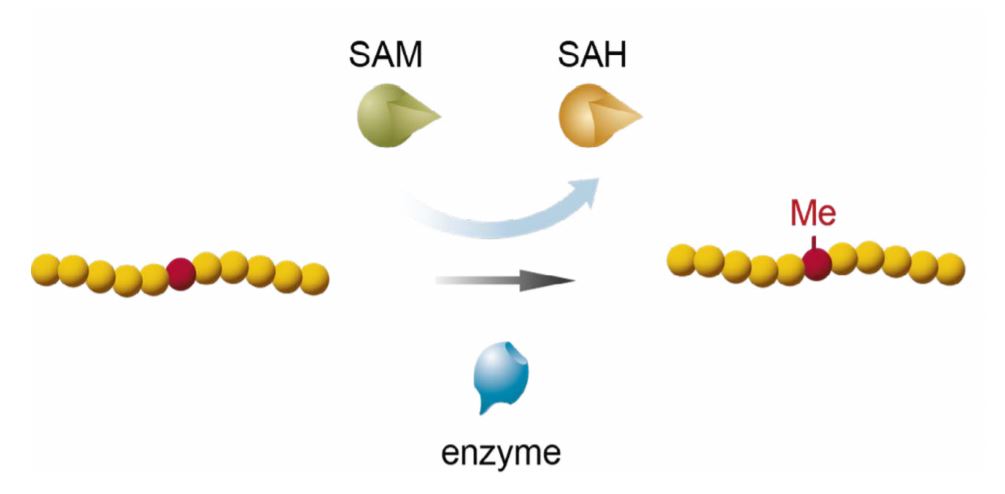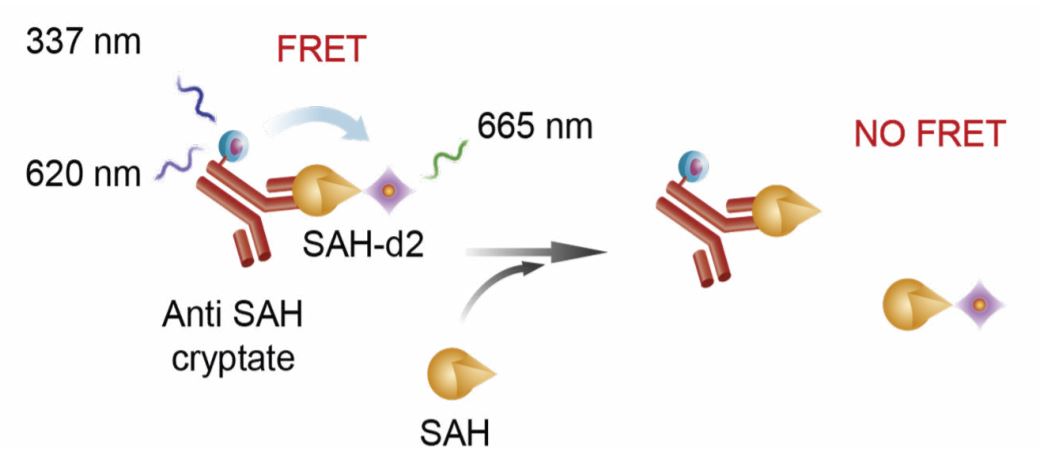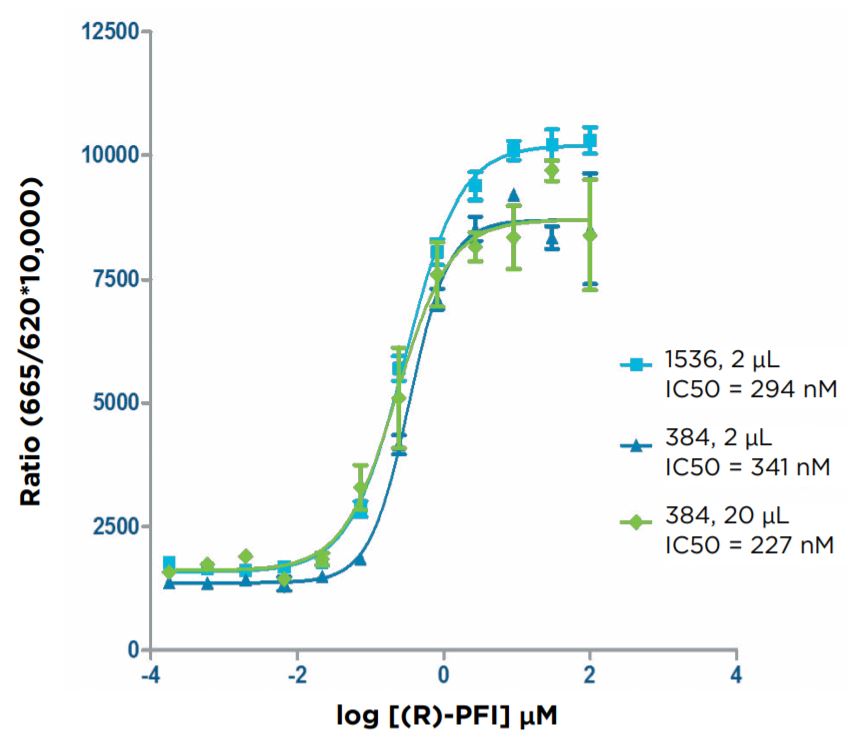Miniaturized EPIgeneous HTRF Assays Using the Echo Liquid Handler
Bonnie Edwards, Nga Tang, Maggie NakamuraAbstract
Cisbio’s HTRF assay technology has a wide range of applications in cell-based and biochemical assays. These assays are readily adaptable to high-throughput screening in 384-well and 1536-well formats. The Echo liquid handler miniaturized HTRF assays to 2 μL assay volumes in 1536-well microplates. Reagents and compounds were transferred at 2.5 nL increments, which enabled flexibility in assay setup and reduced reagent costs. The Set7/9 methyltransferase was used as a model target to verify performance of a miniaturized epigenetic assay.
Introduction
SET 7/9 EPIgeneous HTRF Assay
The EPIgeneous Methyltransferase Assay from Cisbio is a universal solution for all enzymes within the histone and DNA methyltransferase families (HMTs and DNMTs, respectively) that produce S-adenosylhomocysteine (SAH). The methyltransferase activity is assessed by measuring the conversion of S-5’adenosyl-L-methionine (SAM ) to SAH.
In this enzymatic reaction, s-adenosyl methionine (SAM) is used as a cofactor, which is converted to s-adenosyl homocysteine (SAH) as the reaction occurs. The EPIgeneous kit directly quantifies the amount of SAH conversion from SAM.
Figure 1: During the methylation of the H3 peptide, the enzyme cofactor SAM is converted to SAH. Image credit to Cisbio Bioassays.
The EPIgeneous kit contains an anti-SAH antibody coupled to a cryptate donor and d2-coupled SAH. In the absence of native SAH, the cryptate coupled anti-SAH antibody binds to the d2-coupled SAH, resulting in a TR-FRET signal. As SAH is produced in the SET7/9 methyltransferase enzymatic reaction (Figure 1), it competes with the SAH-d2, resulting in a reduction of TR-FRET signal. Conversely, inhibition of the enzyme results in an increase of TR-FRET signal (Figure 2).
Figure 2: Natively produced SAH from the enzyme reaction competes with SAH-d2, resulting in a reduction of TR-FRET signal. (Image credit to Cisbio Bioassays).
Methods
Experiment 1
SET 7/9 Enzyme Titration
The enzymatic activity of the SET7/9 methyltransferase was investigated in Cisbio’s EPIgeneous HTRF assay.
An enzyme titration was first performed using two concentrations of H3 peptide (200 nM and 800 nM), 1 μM SAM, and a 12-point half-log dilution series of SET7/9 starting at 200 nM (Figure 3). Assay buffer, peptide, SAM, and enzyme were added separately to a 384-well Echo qualified polypropylene source plate. 200 nL assay buffer, 400 nL enzyme, 200 nL peptide, and 200 nL SAM were transferred to a 384-well assay plate using an Echo 555 liquid handler. The plate was then sealed and incubated at room temperature (RT) for 60 minutes.
After incubation, Detection Buffer One was added to a 384-well Echo-qualified source plate. 200 nL of Detection Buffer One was then transferred to the assay plate with the Echo liquid handler. The plate was re-sealed, and incubated for 10 minutes. Anti-SAH lumi-Tb cryptate and SAH-d2 were added to the source plate and diluted with Detection Buffer Two. 400 nL of anti-SAH cryptate and 400 nL of SAH-d2 were transferred to the assay plate with the Echo liquid handler. The plate was re-sealed and incubated for another 60 minutes before being read on the BMG LABTECH PHERAstar FS.
Figure 3: SET7/9 enzyme titration with different peptide substrate concentrations.
Experiment 2
(R)-PFI 2 Hydrochloride Inhibition
(R)-PFI 2 hydrochloride is a potent inhibitor of SET7/9 activity. To determine the IC50 of the inhibitor in this assay, a 12-point half-log dose response series starting at 100 μM was generated in DMSO. Each point of the compound dose response curves was first transferred in triplicate to 384-well or 1536-well assay plates with the Echo liquid handler. 40 nM SET7/9 and 800 nM peptide and 1 μM SAM were added with the Echo liquid handler (for enzymatic and detection reagent volumes see Table 1). Enzyme reaction steps and incubations were performed as in the enzyme titration assay. The assay measurements were taken following the final incubation period and plotted as log inhibitor concentration vs. HTRF ratio (see Figure 4).
Figure 4: SET7/9 inhibition curves and IC50 values with (R)-PFI-2 at different assay volumes and plate formats.
As a comparison, the SET7/9 inhibition assay was also performed in a 20 μL assay volume in a 384- well low volume assay plate. 50 nL of compound was added with the Echo 555 liquid handler; the remaining reagent additions were performed with manual pipetting. Reagent volumes were added in accordance to the manufacturer’s protocol; for the miniaturized assay volumes, reagent volumes were reduced in proportion to the total assay volume reduction (Table 1).
| Total Volume | 20 μL | 2 μL |
| Compound | 50 nL | 5 nL |
| Assay buffer | 1.95 μL | 0.195 μL |
| SET 7/9 enzyme | 4 μL | 0.4 μL |
| H3 (1-21) peptide | 2 μL | 0.2 μL |
| SAM | 2 μL | 0.2 μL |
| Detection one buffer | 2 μL | 0.2 μL |
| Anti SAH cryptate | 4 μL | 0.4 μL |
| SAH-d2 | 4 μL | 0.4 μL |
Table 1: Enzymatic and detection reagent volumes.
Results
Experiment 1
SET 7/9 Enzyme Titration
The concentrations of peptide used for the enzyme titration produced similar activities, and the 800 nM concentration was selected for use in the inhibitor evaluation.
Experiment 2
(R)-PFI 2 Hydrochloride Inhibition
IC50 values for the (R)-PFI 2 hydrochloride were comparable between the 384-well microplates and the 1536-well microplates (Figure 4). Data generated with the PHERAstar FS for both 384 well assays exhibited high Z’ factors : 0.83 for the 20 μL assay and 0.88 for the 2 μL assay, and these values were also comparable to the 0.93 Z’ value obtained for the 1536 well assay at 2 μL (see Table 2).
| Assay Format | S/B | Z’ Factor |
| 384 well, 20 μL | 6.4 | 0.83 |
| 384 well, 2 μL | 7.9 | 0.88 |
| 1536 well, 2 μL | 7.3 | 0.93 |
Table 2: Comparison of signal to background (S/B) and Z’ factors of the standard assay volume to the miniaturized assays.
Summary
The Echo 500 series revolutionizes liquid transfer by using acoustic energy to eject fluids. The Echo liquid handler is completely touchless—no tips or nozzles, and no material contacts the sample as it moves from source to destination. The elimination of tips when using the Echo liquid handler provides additional cost savings and eliminates waste, carry-over effects, and cross-contamination. The low volume transfer increment of the Echo liquid handlers enabled the miniaturization of the SET 7/9 HTRF multi-component assays.
All reagents can be transferred with an Echo liquid handler. This can provide significant reagent cost savings, as well as reduction in compound use. The data was of higher quality at the reduced volume, as evidenced by the higher Z’ value for the 1536 well assay in this study.





